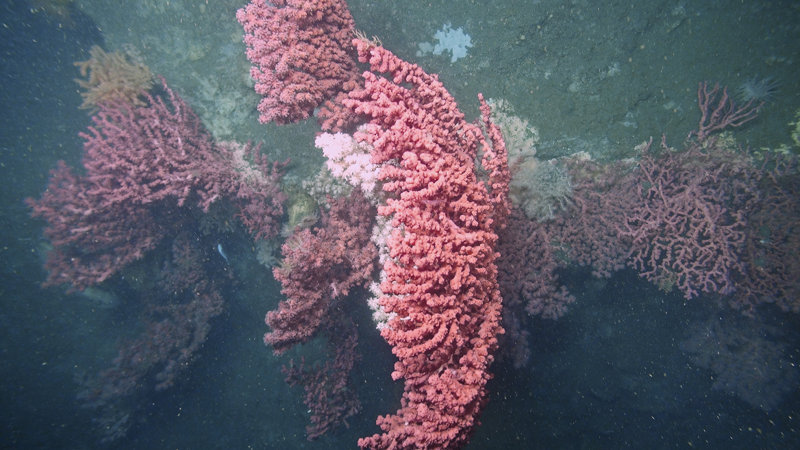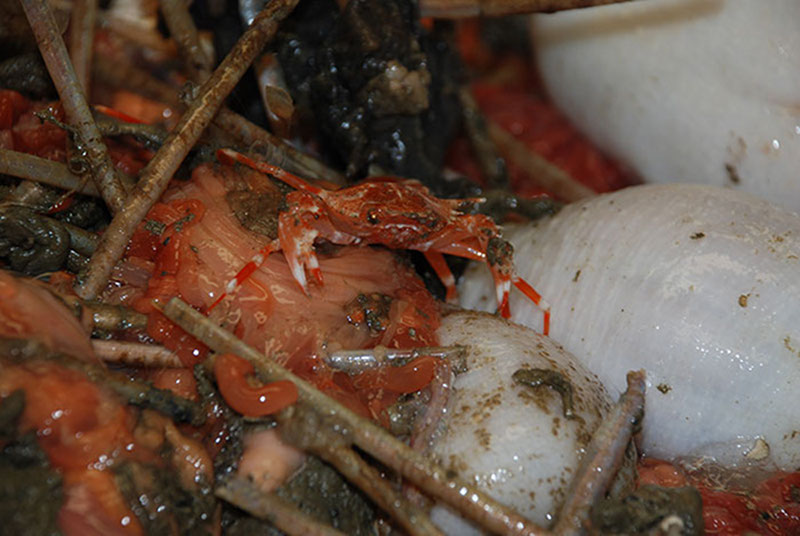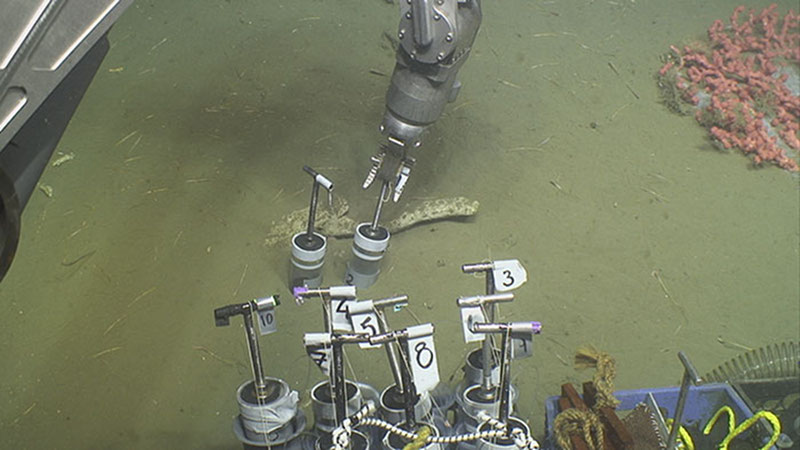
By Frank Cantelas, Maritime Archaeologist - NOAA Office of Ocean Exploration and Research
May 21, 2013

Large colonies of bubblegum coral make the canyon walls their home. BOEM, USGS, and NOAA all have vested interests in deep sea coral ecosystems. Image courtesy of Deepwater Canyons 2013 - Pathways to the Abyss, NOAA-OER/BOEM/USGS. Download larger version (jpg, 6.8 MB).
The current expedition to the Mid-Atlantic Canyons is the most recent in a series over the last decade of successful partnership projects between NOAA’s Office of Ocean Exploration and Research (OER), the Bureau of Ocean Energy Management (BOEM) and the U.S. Geological Survey (USGS). These agencies have partnered together on the Lophelia cruises, Expedition to the Deep Slope, the Deep Gulf Shipwrecks of World War II, and several expeditions aboard NOAA Ship Okeanos Explorer.
Collaboration and partnerships such as this have several significant advantages over each agency undertaking separate, but similar, projects. Cost savings are substantial and the pooling of intellectual knowledge and material resources benefits all partners. The more intangible benefits are the interdisciplinary working relationships that develop between participants that help to make scientific connections that would ordinarily not be made.
NOAA/OER is part of the Department of Commerce while the USGS and BOEM are in the Department of the Interior. Each agency has a different role in the government, yet all three often sponsor similar collaborative activities to collect information about the ocean.

Samples collected by trawling will be used to assess diversity and community ecology of the fishes and megafaunal invertebrates. Image courtesy of Deepwater Canyons 2013 - Pathways to the Abyss, NOAA-OER/BOEM/USGS. Download larger version (jpg, 3.8 MB).
In broad terms, OER’s mission is to scientifically explore and develop baseline characterizations of the ocean to increase our knowledge and understanding of its physical, archaeological, chemical, and biological aspects. BOEM regulates energy development on the Outer Continental Shelf (OCS) and needs to understand these same factors to make informed decisions. USGS is a multidisciplinary agency that provides the nation with information on the health of the country’s ecosystems and environment, the natural hazards that threaten us, and the natural resources we rely on.
OER, BOEM, and USGS have developed a strong partnership since first working together in 2004. This 2013 expedition is part of a four-year project that has a wide variety of scientific objectives to investigate the biology, ecology, geology, and oceanography of the Mid-Atlantic Canyons, with a focus on Baltimore and Norfolk, canyons off Maryland and Virginia. In addition, archeological sites within and adjacent to Norfolk Canyon are being explored and described.

ROV Jason collects sediment push cores that USGS scientists will use to quantify the abundance, biomass, diversity, and community structure of sediment macrofauna and meiofauna (infauna) and analyze the sediment for particle size, organic carbon, nitrogen, and redox chemistry to better understand the sediment environment. Image courtesy of Deepwater Canyons 2013 - Pathways to the Abyss, NOAA-OER/BOEM/USGS. Download larger version (jpg, 1.3 MB).
Projects such as this have carefully coordinated partnerships on many levels, ranging from collaborating government agencies to people working together on the ship. Specifically, NOAA is funding the shiptime and remotely operated vehicle (ROV) system, while BOEM and USGS are funding expedition science. OER is also providing expedition coordination and an educational component. Continental Shelf Associates, Inc. (BOEM contractor), in collaboration with the three agencies, universities, and organizations from around the country, is serving as the science team aboard this mission.
Partnerships offer benefits for all involved. By combining funding and other resources, OER, USGS, and BOEM can accomplish more than they could do alone. For “Deepwater Canyons 2013: Pathways to the Abyss,” OER, USGS, and BOEM have brought together a world-class science team on NOAA’s largest science ship, Ronald H. Brown, with the ROV Jason, a phenomenal national deep submergence asset, which together provide an opportunity for an unparalleled characterization of these largely unexplored deepwater and canyons.
Below is a list of the partnering organizations from this project: